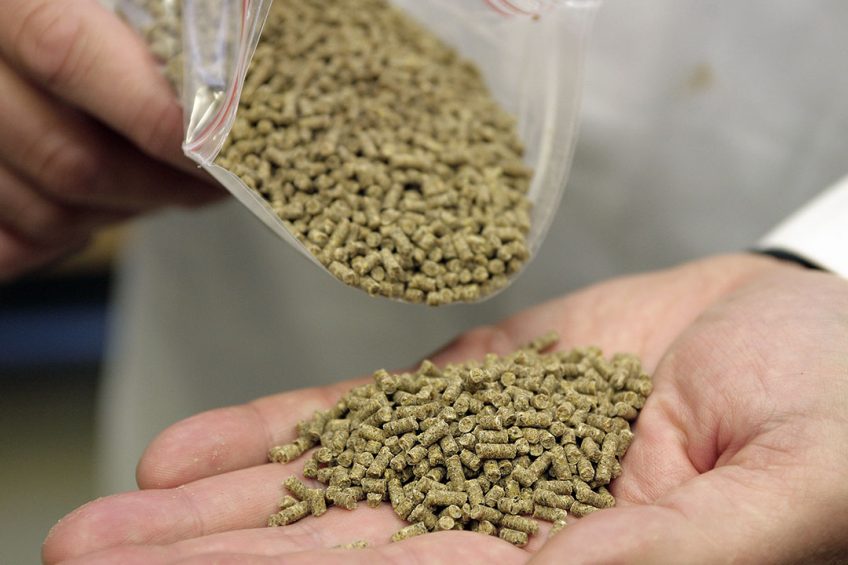Impact of physical form of animal diets

Lowering the grinding intensity of cereals used in compound feeds for pigs or including a share of native/intact cereals in poultry diets is recommended for gastrointestinal health. This not only avoids gastric ulcers in pigs or proventricular dilatation in broilers, but also promotes desired effects on the microflora.
On the one hand it has been accepted worldwide for decades that ruminants need physically effective neutral detergent fibre (NDF) for a physiological development of the gastrointestinal tract (GIT) and its function, including diverse processes like salivation, chewing, ruminating and digestion. On the other hand, i.e. in monogastric species (swine/poultry), there was/is the trend for high grinding intensity, to maximise the digestibility rate and the stability of the pellets produced from finely ground ingredients. There is one interesting fact that was neglected repeatedly in the past: the higher grinding intensity results in higher energy costs, but not conclusively in higher digestibility rates. Already a moderate grinding intensity guarantees ‘normal’ digestibility rates. Comparing studies in which different dietary particle size distributions were used, it can be concluded that a lower grinding intensity of cereals in diets for pigs and poultry without risks for reducing the digestibility rates is possible; with corn perhaps being one exception to this.
Side effects of physical form
For decades it has been known that a high grinding intensity results in higher risks for gastric ulcers in pigs or for proventricular dilatation in broilers. For more than 15 years, the Institute for Animal Nutrition at the University of Veterinary Medicine Hannover, Germany, has been engaged in experimental studies with pigs and poultry to look at the side effects of the physical form of diets. But what does ‘physical form’ mean? It mainly depends on the grinding technique (hammer mill/roller mill) and its final result, the particle size distribution in the diet.
In general, the diets’ particle size is estimated by sieve analysis. If the diet is offered in a dry non-pelleted form, it is a simple technique, but it has to be done in a standardised procedure. Whenever diets are compacted, i.e. pelleted, sieving the native pelleted diet is impossible. Only after soaking, the diet can be transferred to the top of the sieve tower in a liquid form and the particles can pass the sieves depending on the holes, diameter and the particles’ size. The sieves with the retained particles are dried, so that the proportion of particles of different sizes (related to total dry matter at the beginning) can be calculated. But it has to be underlined that there are 2 processes that influence the results markedly:
- First, water-soluble nutrients/constituents are washed out (i.e. in the fraction < 0.2 mm),
- Secondly some constituents are swelling, i. e. they are retained on a sieve with higher diameters of holes.
Regarding the stomach ulcers in pigs there are ‘upper levels of fines’, that should not be exceeded. Several experimental studies indicate, that those risks are increasing if more than 35% of all particles are passing the finest sieve (hole diameter: 0.2 mm; wet sieve analysis). Values up to 50% and more were sometimes observed on farms feeding fermented liquid diets for pigs, accompanied by a high prevalence of gastric ulcers at slaughter. Interestingly in one experimental study it was found that – in spite of a very fine structure – the prevalence of gastric alterations was markedly reduced, when the diet contained higher shares of particles larger than 2.0 mm. But there was one disadvantage that should not be neglected: In the faeces of pigs fed this diet with rolled rye, the starch content increased up to values of 10% of faeces dry matter. That is why this approach cannot be recommended.
Effect of coarse vs fine structure
Numerous experimental studies have been performed, in which – using identical ingredients and chemical composition – the physical form differed only. As presented in Figure 1 there are further interesting side effects, when the diets’ physical form is changed/modified/optimised. These effects start with the process of ingestion, are continued along the stomach, the small and the large intestine, and end up with the process of defecation and faeces quality and composition. In pigs it is noteworthy that the size of salivary glands, the stomachs weight, but also the weight of the pancreas are influenced when diets are compared with a coarse or a fine structure.
Figure 1 – Overview regarding the impact of diets’ physical form on processes of digestion within/on the gastrointestinal tract.

Concerning the effects of different grinding intensities in swine feeding it should be noted that a coarser structure of the diet enables the formation of ‘layers’ within a pigs stomach which prevent the contact of the mucosa at the pars nonglandularis with the strong acid/proteolytic liquids that are typical for the fundus region in a pig stomach.
Furthermore the passage time of digesta through the alimentary tract is affected, as well as the amounts of a diet that reach the hindgut. Using higher proportions of coarse particles from cereals will result in slightly higher amounts of starch that enter the caecum and colon. Thus, also the intensity and type of fermentation are affected, which can be used to minimise the risk for a higher prevalence of Salmonella or for boar taint in fattening male pigs due to a stimulated production of butyric acid. Small amounts of coarse cereal particles generate effects in the hindgut that are comparable to prebiotic substances. In addition, there are effects on the micro-architecture of the gut wall, including influences on the type and amounts of mucines that cover the epithelia.
Limitations for coarse ingredients
There are limitations in the use of coarse ingredients, because exceeding critical levels would result in losses of starch via faecal excretion. Whenever the starch levels in swine faeces exceed ~50 g/kg dry matter, it is necessary to have a critical look on the grinding technique and intensity. In poultry a share of unground cereals can be used because the avian stomach (gizzard) is able to act as a grinder. When the levels of intact/unground cereals exceed critical values (~20% of the diet) the feed intake will be lowered, accompanied by a reduced performance. Maybe the optimised grinding intensity in the future will be based on lowest levels of excreted nutrients (starch, protein, fat). Maximising digestibility rates of legumes (including full fat soybeans) requires a higher grinding intensity than it is necessary for cereals. Cereals also differ regarding the effects of grinding; the higher the grinding intensity, the more pronounced the effects on digesta viscosity. Especially in rye (but also in triticale) the extract viscosity increases enormously if the size of particles is reduced more and more. It has been tested that in sows, especially in pregnancy, a coarser diet favoured the defecation, the moisture content and the bulky character of faeces, which is why it is recommended in herds affected by constipation and secondary problems (including periparturient disorders).













